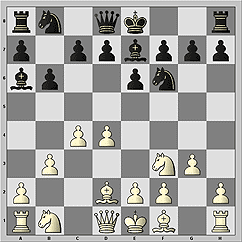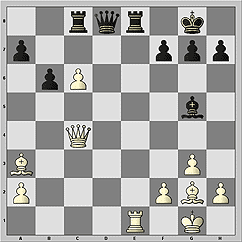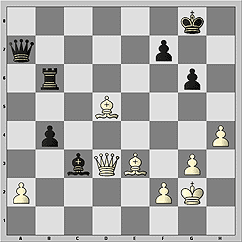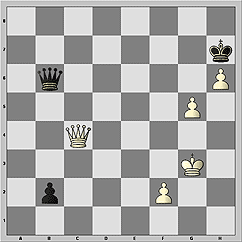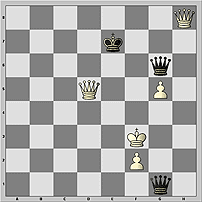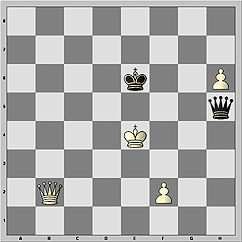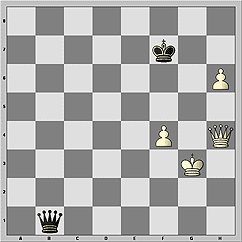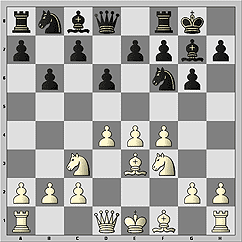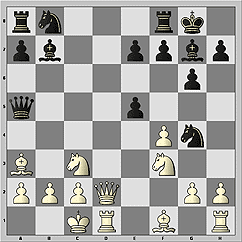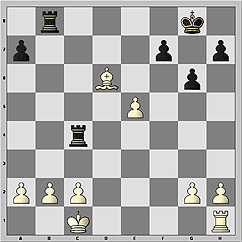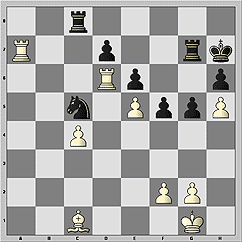 | Последние турниры |
Чемпионат России
СуперФинал

02.12.2006
Суперфинал чемпионата России проходит в Москве, в ЦДШ им. М.М.Ботвинника со 2 по 15 декабря при 12 участниках по круговой системе.
Крамник - Fritz

25.11.2006
С 25 ноября по 5 декабря в Бонне чемпион мира Владимир Крамник сыграет матч из 6 партий с программой Deep Fritz. В случае победы Крамник получит 1 миллион долларов, тем самым удвоив свой стартовый гонорар ($500000).
Мемориал Таля

5.11.2006
В Москве с 5 по 19 ноября проходил Мемориал Таля, в программе которого супертурнир 20-й категории и выдающийся по составу блицтурнир. Призовой фонд каждого состязания - 100.000 долларов.
Топалов - Крамник

23.09.2006
После того как "основное время" не выявило победителя (счет 6:6), 13 октября соперники сыграли 4 дополнительных поединка с укороченным контролем времени.
Томск. Высшая лига

2.09.2006
Со 2 по 11 сентября Томск принимает Высшую лигу чемпионата России 2006 года. В турнире участвуют 58 шахматистов - как получившие персональные приглашения, так и победившие в отборочных состязаниях.
Майнц

17.08.2006
В последние годы фестиваль в Майнце вслед за "Амбер-турниром" стал центром легких шахматных жанров. Наряду с массовыми ристалищами традиционно проходят чемпионские дуэли.
Россия - Китай

10.08.2006
С 10 по 20 августа в Китае проходит товарищеский матч сборных России и Китая. В нынешнем поединке как мужчины, так и женщины соревнуются на пяти досках по шевенингенской системе в два круга.
Все материалы
ChessPro

|
|

|
|
 |
By grandmaster
Sergey SHIPOV |
Out-and-out Chess! |
The encounter of two main favorites in the last round of any event, when tension comes to a boil is the best scenario for chess fans. However, the draw is inexorable – Topalov and Anand met head to head in the second round.
Both still have to prove their favorite status. What if the real favorites are in shadows and will come to a fore closer to the end of the tournament? We can guess as much as we wish… So let’s focus on chess and leave calculations and praises for the second part of the event.
The game between the favorites was very long and energy-consuming. It was a real attrition war! The encounter lasted 100 moves and took 7 hours! The opponents played well but failed to avoid mistakes.
Let me rein up all possible critics first. Have ever seen a soccer player, who never missed a goal? There has never been such a player and I really doubt that he will be ever born. Don’t tell me that playing soccer is more difficult than playing chess. Just have a look at soccer goal – it is so big! However, even Pele, Maradona and Zidan missed. To err is human. The way it is, the way it will be.
From chessic standpoint I like second round better that first one, although all four games were drawn. The GMs are getting into tournament, warming up. In the second round they demonstrated high-level, pithy play. Given a long distance of the event, such an energy outburst might have happened too early. It does not apply to Topalov though. His unique drive and intensity are well-known.
On the other hand it is noticeable that not all the players are in the same tonus. For example Svidler is far from his best. Probably his preparation for the even was ideal. Actually, Peter’s play in Dortmund left a lot to be desired but, as you all remember, it did not prevent him from scoring a decent result. Leko has been performing unconvincingly so far. I tend to attribute it to tremendous pressure he is under. After all, the Hungarian was considered as one of the favorites before the event. He must forget about it and simply do his job – to play chess. Let’s check out the chess stuffing of the second round.
I had no doubts that Veselin would push as hard as he can. The encounters of main favorites decide who will win the title.
Queens-Indian Defense E15
Veselin TOPALOV (BUL) – Vishwanathan ANAND (IND)
1.d4 Nf6 2.c4 e6 3.Nf3 b6 4.g3 Ba6 5.b3 Bb4+ 6.Bd2 Be7
7.Bg2. It is interesting to note that Veselin turned off the path of lavish sacrifices: 7.Nc3 c6 8.e4 d5 9.Qc2 dxe4 10.Nxe4 Bb7 11.Neg5 c5 12.d5 exd5 13.cxd5 h6 14.Nxf7 Kxf7 15.0–0–0 and White prevailed in a very complicated battle (Topalov – Anand, Sofia 2005). Certainly both opponents diligently analyzed this game. If you want to know at what point Black could have played better, ask Vishy.
7...c6 8.Bc3 d5 9.Ne5 Nfd7 10.Nxd7 Nxd7 11.Nd2 0–0 12.0–0 Rc8 13.e4 c5 14.exd5 exd5 15.dxc5 dxc4 16.c6 cxb3 17.Re1 b2 18.Bxb2 Nc5 19.Nc4 Bxc4 20.Qg4 Bg5 21.Qxc4 Nd3 22.Ba3 Nxe1 23.Rxe1 Re8. The opponents played a long theoretical line which was regarded OK for Black. White has a good compensation for exchange, the c6-pawn looks strong, but it is really hard to score the victory.
24.Rxe8+. That is a novelty. It is exactly the case when improving a predecessor is not that hard. The game Sammalvuo – Veingold (Finland 2004) saw 24.Be4?! g6 25.h4?! Bf6 26.Re3 Qd4 27.Qc2 b5 28.Bc5 Qc4 29.Qxc4 bxc4 30.Bxa7 c3 31.Bc5 Re6 32.Kf1 Rce8 33.f3? c2 34.Ba3 Rxc6 and Black won easily.
24...Qxe8 25.Bd5 (only at this point the opponents sank into reflections) 25...h5. Here and many moves down the road Anand was trying to do without g7-g6. I am not sure that this is the only correct approach.
26. Kg2 Be7 27.Bb2 Bf6.
28. Bc1! Even disrupting Black’s pawn structure is not a fair price for the bishop exchange. Thank to two bishops White can constantly pester Black’s heavy pieces. It is extremely important!
28...Qe7 29.Be3. The move 29.Bf4 provoking 29...g5 also deserve attention. In this case the white queen has a chance to infiltrate to f5.
29...Rc7 30.h4 Be5 31.Qd3 Bd6 32.Bg5 Qe8 33.Qf3. What to do with the h5-pawn? Black can’t play g7-g6 in view of the white queen’s invasion to f6.
33...b5! (correctly played!) 34.Be3 (if 34.Qxh5 then 34...Rxc6! Black returns exchange with a roughly equal position) 34...Qe5 35.Qd1 Qe8 36.Qxh5! White has turned down a draw which the opponent silently offered – 36.Qf3 Qe5!
36...Rxc6 37.Bxa7. The endgame arising after 37.Bxc6 Qxc6+ 38.Qf3 Qxf3+ 39.Kxf3 looks drawing - 39...a5 40.Ke4 Be7 41.Kd5 b4 42.Bc5 Bd8! and so on.
37...Ra6 38.Bd4 Bf8 39.Be5 b4 40.Qf5. White keeps some initiative going. If he advances his pawn to h5 and sends another one from g3 to g6, Black will be in real trouble. That is why Anand played...
40...g6! 41.Qf4 Qe7! (this way Black transfers his bishop to g7) 42.Bd4 Ra5 43.Qf3 Bg7 44.Bb6 Rb5. That is the first step toward big problems. Better was 44...Ra6!
45.Be3.
45...Bc3 (at this point Vishy slacked off. He thought his position was safe but did not realize the shaky position of his rook on b5; 45...Ra5!) 46.Bg5 Qa7? Here came a real mistake! Black could have held his ground with 46...Qf8!
47.Qd3! (a double attack at b5 and g6!) 47...Rb6. Another option 47...Qa6 fails to 48.Bd8. Then White removes his king from the h1-a8 diagonal preparing Bd5-c4; 47...Qb6 is also met with 48.Bd8.
48.Be3.
At this point Anand took an interesting decision. I am sure that in this position just a few would make the move 48...Qa6!? It looks like Black can hold the opposite-color bishop endgame that emerges after 48...Qc7 49.Bxb6 Qxb6 – indeed in the kingside only Black’s position is defendable. However, White can play 50.a4! creating a passer at the queenside. This position is much more difficult to hold.
49.Bxf7+! (This elegant blow brings White two extra pawns) 49...Kxf7 50.Qd7+ Kf8 51.Qd8+ Kf7 52.Qc7+ Kg8 53.Qxb6 Qxa2 54.Qxg6+ Kh8.
It looks like Vishy deliberately went for this position. He probably thought that advancing b4-pawn promised a saving counterplay. Speaking objectively, Black’s position is lost. However, he has some practical chances and the Indian GM proved it!
55.Qc6 Qf7 56.g4! Bg7 (otherwise Black can’t get his passer advance) 57.h5. Another winning method is to construct a mate box for the black king – 57.g5 b3 58.g6 Qg8 59.h5 b2 60.Qb7 Qe6 and here for example 61.Bf4 Qf5 62.Be5!! Qg4+ 63.Bg3 Qf5 64.h6 Qxg6 65.hxg7+ Qxg7 66.Qxg7+ Kxg7 67.Be5+ and Black has to lay down arms.
57...b3 58.Qe4 b2 59.h6 Bf6.
I think by this moment Veselin got really tired. In the time trouble mutual mistakes crept in.
60.Bd4. White could have closed the game with 60.g5! Qe7 (60...Bc3 61.g6!) 61.Qxe7 Bxe7 62.Bd4+ Kh7 63.Bxb2 Bxg5 64.Bg7. As Black can’t trade the bishops on h6 White has not problems winning with two extra pawns.
60...Kg8 61.Bxf6 Qxf6
In this position White’s victory is doubt, at least for a human being at the seven hour in the time the second trouble. Queen endings are very difficult to play. There are too many lines, too many positional guidelines.
62.Kg3. Better was 62.f3! For example 62...Qb6 63.g5! Kf7 (63...b1Q 64.Qe8+ Kh7 65.Qf7+ Kh8 66.Qg7#) 64.Qh7+ Ke8 65.Qg8+ Kd7 66.Qg7+ Kc6 67.Qg6+ Kc5 68.Qxb6+ Kxb6 69.h7 b1Q 70.h8Q+–.
62...Qb6! 63.Qc4+ (now 63.g5? fails to 63...Qb8+! and that is Black who wins!) 63...Kh7 64.g5.
64...Qg6! (the only move) 65.Qc7+ Kg8 66.Qb8+ Kf7. Another one! Bad was 66...Kh7? 67.Qb7+ Kg8 68.h7+!
67.Qb7+ Kf8 68.Qb8+ Kf7 69.Qb3+ Kf8 70.Qf3+ Ke7. 70...Kg8? is a red herring - 71.Qa8+ Kf7 72.Qd5+ Ke7 73.h7! b1Q 74.h8Q Qg1+ 75.Kf3
Two black queens can’t deliver a single check!
71.Qe3+ Kd7 72.Qd4+ Ke6. Black had an elegant saving line at his disposal: 72...Qd6+ 73.Qxd6+ Kxd6 74.h7 b1Q 75.h8Q Qg1+ 76.Kf3 Qd1+! (after 76...Qxg5? 77.Qd4+ White trades the queens and transposes into the winning pawn endgame) 77.Kf4 Qc1+ 78.Kf5 Qb1+ 79.Kg4 Qg1+ with perpetual.
73.Qxb2 Qxg5+ 74.Kf3 Qh5+ 75.Ke4
75...Qf5+?! (the easiest way to save the game was 75...Qg6+!) 76.Ke3 Qg5+ This is the decisive mistake. The question mark is inappropriate here because this position is beyond human capacities. The line 76...Qh3+ 77.Kd4 Qg4+ 78.Kc5 Qh5+ 79.Kc4 Qd5+ 80.Kb4 Qb7+…let me stop here. Black escapes by narrow margin with many precise moves.
77.f4 Qg3+ (the h6-pawn is taboo due to the queen loss) 78.Ke4 Qe1+ (78...Qg6+ 79.Kf3 Qh5+ 80.Kg3 Qg6+ 81.Kf2+–) 79.Kf3 Qf1+ 80.Kg3 Qg1+ 81.Qg2 Qb1 82.Qc6+ Kf7 83.Qd7+ Kf6. This position is easily winning for White, providing that he does not blunder perpetual…
84.Qg7+ Ke6 85.Qe5+ (more accurate was 85.Kh2! Qc2+ 86.Kh3 Qd3+ 87.Kh4+–) 85...Kf7 86.Qh5+ Kf6 87.Qg5+ Kf7 88.Qh5+ Kf6 89.Qh4+ Kf7
90.h7? The last mistake! Let’s refrain from criticizing Veselin. Everyone could be in such a situation. Nevertheless, a well-known principle of queen endgames read that the party who has some extra material should keep his queen closer to the center. This approach offers a chance to avoid the perpetual, whereas at the edge of the board the queen can’t help her king. We see it happen in this particular case.
90...Qe1+! 91.Kg4 Qd1+ 92.Kg5 Qd8+ 93.Kh5 Qd5+ 94.Qg5 Qh1+ 95.Qh4 Qd5+ 96.Kg4 Qd1+ 97.Kg3 Qe1+ Draw! Topalov was fortuned in the first round; Anand had his portion of luck today. Both are Fortune’s favorites. One of them should grab the title…
Sicilian Defense B90
Peter LEKO (HUN) – Alexander MOROZEVICH (RUS)
1.e4 c5 2.Nf3 d6 3.d4 cxd4 4.Nxd4 Nf6 5.Nc3 a6. I think the first round results determined Morozevich’s opening choice. Alexander wanted to take advantage of Leko’s poor condition after his vexing defeat from Topalov.
6.f3 e6 7.Be3. The English attack is a very complicated variation requiring deep preparation of both parties. Otherwise an inglorious defeat is imminent.
7...Be7 8.Qd2 0–0 9.g4 Nc6 10.0–0–0 Nd7 11.h4 (White is first to launch a pawn attack but it is still a long way to go) 11...Nde5 12.Qf2 Bd7 13.Kb1.
13...Na5. That is an interesting novelty. Black leaves his knight on a5 for a while. After 13...b5 14.g5 Qc7 15.Qg3 Nxd4 16.Bxd4 b4 17.f4 bxc3 18.fxe5 cxb2 19.exd6 Bxd6 20.Qc3 Bc6 21.Bxg7 Bxe4 22.Qxc7 Bxc7 23.Bxf8 Bxh1 Black transposed into a good ending (Arizmendi Martinez - Stevic, Istambul 2003). In another new-century game Black did not do nearly as well: 13...Qc7 14.Rg1 Nxd4 15.Bxd4 b5 16.f4 Nc4 17.Bxc4 Qxc4 18.g5 Rfc8 19.Qd2 b4 20.Ne2 e5 21.b3 Qc6 22.Bb2 Ra7 23.Ng3 – White has a powerful attack (Socko - Solodovnichenko, Barlimek, 2002).
14.g5 Nec4 15.Bc1 (Naturally, it makes no sense for White to trade one of Black’s knights. Let them brawl about the c4-square!) 15...b5 16.f4 b4 17.Nce2 Qb6 18.Rh2.
18...d5! (Just in time! Even a short delay could have cost Black dearly) 19.exd5. The transposition to the French pawn structure is in Black’s favor – 19.e5 Bc5 20.Qf3 Nc6 21.Nb3 a5 and so on.
19...Bc5! (A pawn here a pawn there – it doest not really matter. It is much more important to grab initiative.) 20.Qf3 Rad8 21.Nb3 Any deviation from sharp matter-of-principle continuations is an indicator of poor form. Instead of retrieving his knight from the center Peter should have launched the attack of his own with 21.f5!
21...Nxb3 22.axb3 Ne3 23.Bxe3 Bxe3 24.Rd3 Bc5 25.dxe6 Bxe6. When the center is open two-bishop advantage is quite tangible.
26. Nc1 g6?! Let’s put it this way, the move made by Morozevich was not obligatory. Why to create a target for the opponent’s attack. The bishop transfer to the queen side 26...Bd7!? deserved a closer look.
27.Bh3 Naturally, the trade of bishops favors White. One may think that it is inevitable but Morozevich found a brilliant rejoinder…
27...f5 28.gxf6 Bf7! (The bishop hid from his opponent, whereas White’s f6 pawn is doomed anyway.) 29.f5 Both opponents were in time trouble by this point. Morozevich did a better job at this stage of the game.
29...Bd4 30.fxg6 hxg6 31.Qg4 Bxf6 32.Re2 a5 33.Re4 Kg7 34.Qg3 Rh8 35.Bf5 Rh5 36.Rxd8 Qxd8 37.Be6 Bxh4 38.Qg2 Be8 39.Rg4 Re5 40. Bc4 Re1
The dust has settled. Black not only regained the pawn but also obtained a solid positional advantage. He has the remote passer and two powerful bishops. White can only hope for his active pieces.
41.Bd3 Qf6 42.Qd2 Qf2 43.Be2! (the queen exchange is deadly for White) 43...Bf6 44.Rc4 Qg3 45.Rc7+ Qxc7 46.Qxe1. White managed to get rid of the pin along the first rank, but after trading the rooks Black’s king feels much safer.
46...g5 47.Nd3 Bg6
(The white king although covered with pawns feels some discomfort) 48.Qg1 Qe7 49.Bg4 Qe4 50.Qg3 Bf7 51.Qh3 Bd5 52.Bf5. That is the key moment of the game.
52...Qh4 It is hard to understand why Alexander did not trade the queens. Apparently, he wanted to do so in a better situation but the opponent was not in the mood to cooperate. I am sure that much better was 52...Qh1+! with a sizable advantage in the endgame.
53.Qe3 Qd4 54.Qg3 Bf7 55.Qg2 Qd5 56.Be4 As a good Russian bard once said: “Now he can’t do what he used to be just lazy for” White skillfully avoided exchanging and foiled Black’ active operations.
56...Qe6 57.Nc5 Qd6 58.Nd3 Be6 59.Qh1 Qd4 60.Qh7+ Kf8 61.Bf5 Bf7 62.Qh6+ Ke7 63.Qh2 Qd6 64.Qh7 Qb8 65.Bg4! Kf8 66.Qh6+ Ke7 67.Qh7 Kf8 68.Qh6+ Ke7.
Draw.
The next game remained incomplete per se. This fact really pleased the fans of four-fold Russian champion.
Pirc Defense B06
Rustam KASIMDZHANOV (UZB) – Peter SVIDLER (RUS)
1.e4 g6 2.d4 Bg7 3.Nc3 d6 4.f4 Nf6 5.Nf3 0–0 6.Be3 b6. That is an interesting variation of the Pirc Defense. Since White transfer his king to the queenside Black resolutely opens the position to be first with an attack.
7.Qd2 Bb7 8.e5 Ng4 9.0–0–0 c5! 10.dxc5 bxc5 11.Bxc5 Qa5 12.Ba3 dxe5. It turned out that this position occurred in many games. Rustam introduces a new strong move.
13.Nd5!? White stifles the activity of Black’s pieces with exchanges. In the game Illescas Cordoba - Marin, Monrariz (2002) stormy complications ensued: 13.h3 Bh6 14.Ng5 exf4 15.Nxf7 Rxf7 16.hxg4 Bg5 17.Ne4 Qxd2+ 18.Nxd2 f3 19.gxf3 Bxf3 20.Bc4 Bxh1 21.Rxh1 Nc6 22.Bxf7+ Kxf7 23.Rxh7+ Kf6 24.b3 Bf4. As a result a roughly equal endgame arose.
13...Qxd2+ 14.Rxd2 Bxd5 15.Rxd5 Ne3 (the line 15...Bh6 16.Bxe7 Bxf4+ 17.Kb1 Re8 18.Bg5 does not offer a complete equality. For example: 18...Ne3 19.Rc5 Bxg5 20.Nxg5 h6 21.Bb5! etc..) 16.Rd2 Nc6 17.Bb5 Rfc8 18.Bxc6 Rxc6 19.Nxe5 Bxe5 20.fxe5.
20...Nc4 (after 20...Rac8 21.c3 Nc4 22.Bxe7! the consequences are very similar) 21.Bxe7! (it is a very profitable exchange rather than a sacrifice) 21...Nxd2 22.Kxd2. The bishop with two pawns are much stronger that a rook. White’s pawn attack at the queenside is inevitable.
22...Rb8 23.Kc1 (the time trouble takes its toll; why not 23.b3?) 23...Rc4 24.Bd6.
Why did opponents seal a draw at this point? Probably Rustam was under impression that the black rooks engineer some serious counterplay. One way or another, unbiasedly speaking White’s advantage is undisputable.
Judit’s fans have all the reasons to feel happy. The queen of chess managed to withstand Adams’ pressure after the first round defeat. I think things will sort themselves for Judit down the road.
Sicilian Defense B48
Michael ADAMS (ENG) – Judit POLGAR (HUN)
1.e4 c5 2.Nf3 e6 3.d4 cxd4 4.Nxd4 Nc6 5.Nc3 Qc7 6.Be3 a6 (that is a modern interpretation of the Paulsen variation) 7.Bd3 b5 8.Nxc6 Qxc6 9.e5 Bb4 10.0–0.
10...f5. Here comes the first surprise for the opponent. The game Adams - Lutz (Leon, 2001) went 10...Bxc3 11.bxc3 Bb7 12.Qg4 Ne7 13.Bd4 Ng6 14.Rae1 Qc7 15.Re3 h5 16.Qg3 Ne7 17.Qg5 Qd8 18.Rg3 g6 19.Qf6 Rg8 20.Bc5 Rc8 21.Bd6 Nf5 22.Bxf5 Qxf6 23.exf6 exf5 24.Rd1 and White got a dangerous initiative.
11.Be2 Bb7 12.Bh5+!? With this interesting novelty White forces Black to loosen the dark squares in her camp. Previously White tried 12.Bf3 Qc8 13.Bxb7 Qxb7 14.Ne2 Ne7 15.a3 Ba5 16.Nf4 Bc7 17.Bd4 0–0 18.Bc5 Bxe5 19.Bxe7 Bxf4 20.Bxf8 Rxf8 but Black get a decent compensation for the exchange (Baxter - Smith, Whitby, 1962).
12...g6 13.Bf3 Qc8 14.Bd2 (with a simple threat Nc3xb5! followed by the check from d6) 14...Bxc3 15.Bxc3 Ne7 16.Bb4 Bxf3 17.Qxf3 Nd5 18.c3. The d5-knight is a stronghold of Black’s defense. Therefore White’s task is to make this knight move.
18...Qc4 19.Rfd1 Qg4 20.Qd3! (obviously, the queens exchange favors Black in this position) 20...Kf7 21.h3 Qf4 22.Qe2 Qc4 23.Qf3 a5 24.Bd6 a4 25.Rd4 Qc6 26.Rad1. White did a good job dislodging the black queen from the center. How to continue the attack? The sacrifice on d5 suggests itself, but it is not Michael’s style. As long as White can improve his position Adams will do so with no commitments. 26...h6 27.R1d3 Kg7 28.Kh2 Rac8 29.Qg3 Kh7 30.Qh4 Rhg8 31.Rg3. Judit decided to launch some active operations but it just aggravated her problems.
31...g5 32.Qh5 Rg7 33.Qd1 Nf4 34.h4 Rh8 35.Kg1 Kg8 36.b3! (Michael timely opened the second front) 36...axb3 37.axb3 Rhh7. Black is prepared for opening the g-file.
38.h5! After this strong move the black rooks look comical.
38...Rh8? (Judit committed this mistake in the time trouble; she should have started this regrouping with 38...Kh8) 39.Ba3. White could have forced the exchange of minor pieces with an elegant 39.Be7! For example: 39...Rxe7 (39...Nd5 40.Bf6!) 40.Rxf4 Kg7 41.Rd4 Ra8 42.Rgd3 Ra7. White is clearly better although he has to work hard to convert his advantage into the victory.
39...Kh7 40.Bc1 Nd5 41.c4. (necessary activity; otherwise White could have found himself in an inferior position) 41...bxc4 42.bxc4 Nb6.
43.Rd6. The option 43.Rb3! Rc8 44.Be3 deserves attention. In my opinion White have a dangerous initiative. The black king is vulnerable in some lines, whereas White’s h5-pawn is a great attacking tool.
43...Qa4! 44.Qxa4 Nxa4 45.Ra3 Nc5 46.Ra7 Rc8. Black is just in time to coordinate his pieces.
47.Be3 f4 48.Bxc5. Black should hold this rook endgame. Draw.
Standings after the second round: 1-2. Topalov and Anand – 1.5; 3-6. Svidler, Kasimdzhanov, Morozevich, Adams – 1; 7-8. Leko and Polgar – 0.5.
|
|

